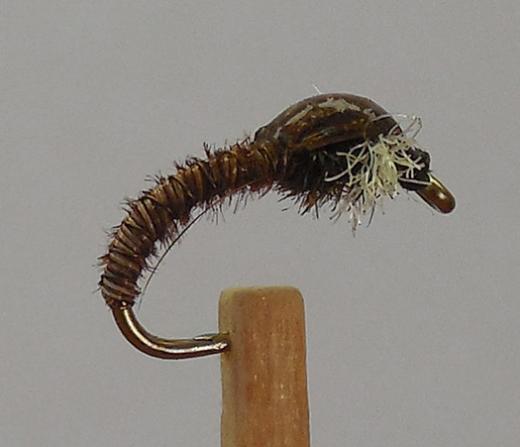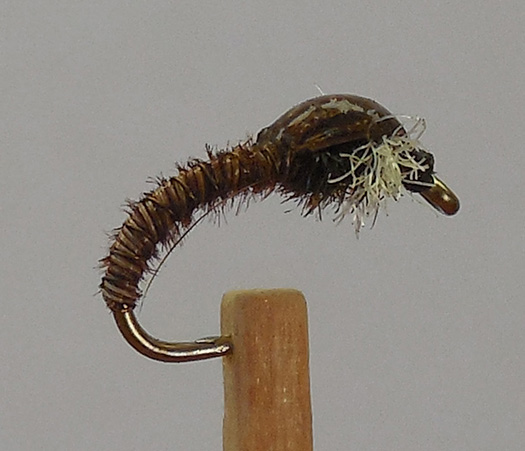The Trout Line Newsletter - Feb. 19, 2018
THE TROUT LINE
Feb. 19, 2018
Welcome to The Trout Line Newsletter! This is our Tualatin Valley Trout Unlimited Chapter newsletter that will be coming out twice a month on the 1st and 3rd Mondays of the month.
Fly of the Month - Mike's Scud Hook Chironomid
Written by Mike Gentry.
Chironomids constitute a substantial portion of the food chain in many lakes, in terms of number and presence and probably in terms of volume as well. From my non-entomologist's point of view, sitting in my pontoon boat, I've made a few observations that seem right to me. While some of the other staples on the lake table smorgasbord are more seasonal or weather-sensitive, adult midges are almost always flitting around or cashed in on the surface. And I've never fished a day in any weather where there was not reliable and predictable action on larval/pupal stages. So here is one of my most reliable patterns. To those who say that this pattern bears a tweaked, bent-hook resemblance to Brian Chan's chironomid rendition, I say "mind your own business".
Hook: Tiemco 2457, sizes 12-16
Thread: Dark Brown or Black 8/0
Body: Pheasant Tail Fibers
Rib: Fine copper wire
Thorax: Peacock herl
Gills: White antron
Shellback: Pheasant Tail Fibers
1. Tie in a piece of wire far down the bend of the hook, leaving the wire sticking out behind the hook.
2. Tie in five or six long Pheasant tail fibers by the tip at the same point, and wind the thread forward to about 1/3 of the way behind the eye.
3. Gently wind the fibers forward to the thread, and tie off with several wraps of thread so that the butt ends of the fibers are piled on top of the hook. Gently bend the fibers back (upright) to get them out of the way for the moment. If the remaining fiber but ends are too short (you need a half inch or more), clip them off and tie in longer fibers.
4. Counterwind the wire ribbing in six or so turns to the fiber tie-in point, then one or two turns forward of the fibers (keeping them up out of your way), tie off and clip the wire.
5. Tie in a strand of Peacock herl just in front of the fibers and angle it back, out of the way for the moment.
6. Take a one inch or longer strand of antron and lash it perpendicular on top of the hook about halfway between the back of the eye and the front of the body, with five or six figure-eight turns of thread, lightly at first and then tighter as the antron gets secured on the hook. The antron should stick out sideways like airplane wings. Wind the thread to the back of the eye.
7. Gently wind the Peacock herl forward, winding several turns behind and then in front of the antron sticking out on each side. Ideally (but not required), also add several crossing winds over and under the antron tie-in point to build a little thicker thorax at that point. End with the herl at the back of the eye, tie off and clip excess.
8. Bend the Pheasant tail fibers forward on top of the hook over the thorax to the back of the eye, pull gently forward to tighten the fibers down on top the thorax, and tie off the fibers with several wraps of thread. Trim the fibers tight against the thread wrap so as not to cover up the hook eye.
9. Finish the head with several half-hitches, trim and cement. Then clip off the antron on each side to stick out just beyond the side of the thorax.
Meetings Location and Dates
Regular chapter meetings are held at the Lucky Labrador Public House 7675 SW Capitol Hwy. Portland, OR 97219 (503) 244-2537. Food and beverage available. Social get together starts at 6:30 pm and formal meeting starts at 7:00 pm unless otherwise noted in the newsletter or website.
March 14, 2018 (Joint Meeting with Stonefly Maidens)
Speaker: Jason Borger
Topic: Nymphing Concepts
Jason Borger grew up in the world of fly fishing, and has been involved in fly-fishing education and the industry in general for much of his life. His work in the study and teaching of fly casting has lead to his involvement as a fly-fishing consultant and double the commercials and movies, including A River Runs Through It and The River Why. Since his teens, Jason has been teaching, shooting videos, and writing articles and books on fly fishing. His book, Single-Handed Fly Casting, is considered one of the key modern works on the subject. He also co-founded the Fly Casting Institute, which is dedicated to advancing the science, medicine and art of fly casting. In addition to his angling background, Jason has professional history in illustration and production graphic design, as well as a degree in film and television production graphic design, as well as a degree in film and television production and theory. For more information visit fishfliesandwater.com.
More Information:
TVTU Website: https://tualatinvalley.tu.org/
Current Board Members and Contact:https://tualatinvalley.tu.org/tualatinvalley/about
TVTUBlog: http://tvtroutunlimited.blogspot.com/
TVTU Facebook Page: https://www.facebook.com/tualatinvalleyTU/
C4C Facebook Page: https://www.facebook.com/christmasforcoho/



